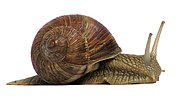spiral, and even a star-shaped form. The oldest rudists are found in late Jurassic rocks in France. The rudists became extinct at the end of the Cretaceous...
7 KB (739 words) - 12:39, 11 January 2024
and seas were populated with now-extinct marine reptiles, ammonites, and rudists, while dinosaurs continued to dominate on land. The world was largely ice-free...
95 KB (9,855 words) - 21:37, 4 October 2024
Ordovician period, 488 to 443 million years ago. One bivalve group, the rudists, became major reef-builders in the Cretaceous, but became extinct in the...
96 KB (9,742 words) - 08:41, 4 October 2024
decline. More modern teleost fish begin to appear. Ammonoids, belemnites, rudist bivalves, sea urchins and sponges all common. Many new types of dinosaurs...
174 KB (9,789 words) - 07:21, 2 October 2024
relatives of Megalodon such as Pachyrisma grande were closely related to the rudists. †Megalodon hungaricum †Megalodon longjiangensis †Megalodon rostratiforme...
3 KB (164 words) - 12:55, 13 February 2024
bryozoa, and parts of the shells of some bivalves (such as oysters and rudists). Calcite is found in spectacular form in the Snowy River Cave of New Mexico...
46 KB (4,825 words) - 22:36, 30 September 2024
Sierra Madre Formation (section Rudists)
lagoonal to estuarine environment and contain many fossil fish, flora and rudists, typical reef-building organisms of the Cretaceous. The formation rests...
9 KB (689 words) - 03:54, 17 July 2024
plesiosaurs, several groups of mammals, ammonites (nautilus-like mollusks), rudists (reef-building bivalves), and various groups of marine plankton. In all...
283 KB (28,268 words) - 03:24, 18 September 2024
order of bivalves known as rudists, were major reef-building organisms during the Cretaceous. By the mid-Cretaceous, rudists became the dominant tropical...
163 KB (18,217 words) - 19:38, 16 September 2024
Caprinidae is a family of rudists, a group of unusual extinct saltwater clams, marine heterodont bivalves in the order Hippuritida. These stationary intermediate-level...
2 KB (115 words) - 13:13, 12 November 2022
later successions included stromatoporoids, corals, algae, bryozoa, and rudists (a form of bivalve mollusc). The extent of organic reefs has varied over...
72 KB (8,485 words) - 15:26, 13 August 2024
genus diversity experienced a gradual increase throughout the period. Rudists, the dominant reef-building organisms of the Cretaceous, first appeared...
232 KB (25,073 words) - 20:04, 3 October 2024
feed on detritus. Coccolithophorids and mollusks (including ammonites, rudists, freshwater snails, and mussels), and those organisms whose food chain...
200 KB (21,686 words) - 18:46, 3 October 2024
Radiolitidae is a family of rudists in the order Hippuritida. These rudists lived between the Jurassic and the Cretaceous (age range: 130.0 to 66.043...
4 KB (268 words) - 11:33, 2 February 2022
February 2020). "Subdaily-Scale Chemical Variability in a Rudist Shell: Implications for Rudist Paleobiology and the Cretaceous Day-Night Cycle". Paleoceanography...
40 KB (4,225 words) - 01:45, 17 August 2024
Ordovician – Recent] Pachydonta: Large, different, deformed teeth (e.g. rudist spp.). [ Late Jurassic – Upper Cretaceous] Desmodonta: Hinge-teeth absent...
122 KB (13,234 words) - 06:08, 31 August 2024
It bears fossil animals from the Mesozoic era (140 My), particularly rudists. For several species, the reef represents the locus typicus. The local...
4 KB (228 words) - 09:11, 4 May 2024
Bibcode:1994CorRe..13....3C. doi:10.1007/BF00426428. S2CID 42938715. "The Rudists". University of California Museum of Paleontology. Retrieved 2008-11-27...
81 KB (8,949 words) - 08:18, 13 September 2024
in eastern China. 155 Ma First blood-sucking insects (ceratopogonids), rudist bivalves, and cheilostome bryozoans. Archaeopteryx, a possible ancestor...
85 KB (4,733 words) - 00:11, 13 September 2024
especially members of the red algae (Rhodophyta), and molluscs (especially the rudist bivalves during the Cretaceous Period) have created massive structures at...
16 KB (1,584 words) - 03:45, 28 July 2024
Formation is a geologic formation in Jamaica. It preserves fossils such as rudists, echinoids and corals from the Santonian stage of the Cretaceous Period...
2 KB (92 words) - 23:12, 17 December 2021
abundant rudist bivalves within the Caribbean faunal province', the International Union of Geological Sciences (IUGS) included the 'Late Cretaceous rudist bivalves...
3 KB (217 words) - 15:02, 31 January 2024
development of coral reefs, which abounded with molluscs, particularly rudists. These were the origin of the Urgonian Limestone which forms the upper...
22 KB (2,395 words) - 02:12, 18 September 2024
invertebrates known to have lived in this sea include various species of rudists, crinoids and cephalopods (including squids and ammonites). Large fish...
113 KB (12,424 words) - 16:34, 17 July 2024
bivalve molluscs in the order Hippuritida, family Requieniidae. These rudists lived in the Cretaceous period, from the Valanginian age (136.4–140.2)...
2 KB (106 words) - 15:01, 18 September 2021
1–180, retrieved 2019-02-06 A. Torre. 1960. Notas sobre rudistas [Notes about rudists]. Memorias de la Sociedad Cubana de Historia Natural 25(1):51-64...
2 KB (81 words) - 19:01, 15 July 2024
Diceratidae is a family of rudists, a group of unusual extinct saltwater clams, marine heterodont bivalves in the order Hippuritida. Genera within the...
1 KB (41 words) - 16:01, 4 February 2022
Caprina is a genus of rudists, a group of marine heterodont bivalves belonging to the family Caprinidae. These stationary intermediate-level epifaunal...
2 KB (85 words) - 21:07, 17 December 2021
ostreid is Konbostrea, with shell height reaching up to 1.2 m (3 ft 11 in). Rudist Titanosarcolites had overall size around 2 m (6 ft 7 in). Complete shell...
391 KB (40,753 words) - 20:02, 4 October 2024
formation comprises micritic limestones, in places karstified and dolomitized. Rudists and fossil ankylosaur, sauropod and theropod tracks have been reported...
6 KB (402 words) - 19:46, 8 July 2024























